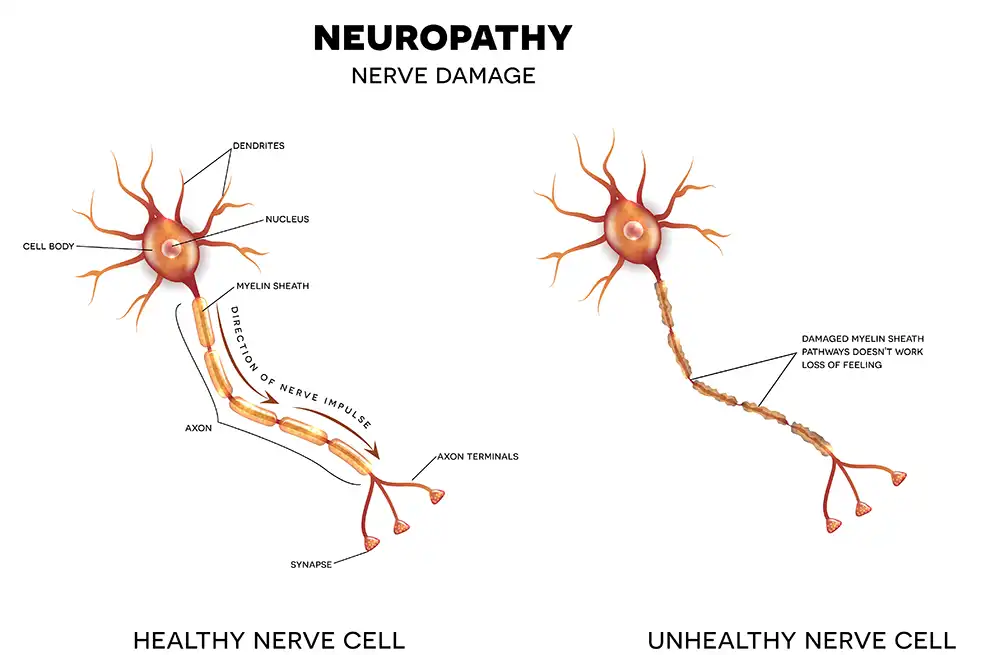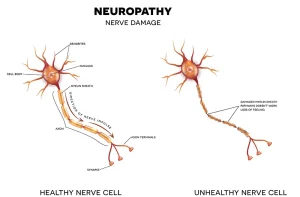Everything your Doctor doesn’t have time to explain about neuropathy
Hi! If you’re reading this, chances are that you may be suffering from peripheral neuropathy, or perhaps your doctor has given you a diagnosis but you are still unsure what it means.
Each case of peripheral neuropathy is unique.
Multiple symptoms can be caused by different causes and as a result, we have a huge confusion all over the place.
Why? Because your nervous system can be affected by so many things.
A Simple Explanation About Your Nerves
Before we get into the various types of peripheral neuropathy, it is important to briefly review your peripheral nervous system.
Most people are aware of the fact that nerves transmit signals throughout your body. They relay information from one area to the next.
Motor nerves are what allow your brain to tell different parts of your body when they should move.
Sensory nerves transmit information to the brain and spine about pressure, pain, vibration, and other things.
The autonomic nerves control things we can’t control consciously, such as our heart rate or digestive system.
Your nervous system is split between the central nervous system, located in the brain and spine, and your peripheral nervous system. This includes all radiating outwards.
The cell bodies are closer to your central nervous system, but the axon should be the focus. The axons are like branches that extend from your nerve bodies to your toes and the tips of your fingers.
The myelin sheath is essentially a protective layer of fats and proteins that covers the axes. It helps protect thicker nerve fibers and speeds up their ability to transmit information.
Once an impulse or message has been sent down the axon branches it must cross a thing called a synapse. This is basically a space between neurons. This is how the message reaches the next nerve or the body part it is delivering.
The peripheral neuropathy has a tendency then to work in one or more of the following ways:
- Damaging the myelin sheath (demyelinating neuropathy).
- Damaging the axon (Axonal neuropathy)
- Increasing the space between nerves
Different types of nerve damage
When peripheral neuropathy becomes a concern, it is important to determine the extent of the damage caused.
Neuropathy generally takes its toll in one way or another.
Demyelinating Neuropathy
There are many lengths of nerve fibers or axons. There are many sizes, including smaller ones, medium-sized ones, and larger ones. It is not surprising that larger individuals tend to have heavier informational loads. They are also more likely to need to transmit information quicker than their smaller counterparts.
The larger nerve fibers responsible for motor functions and sensory relay are usually the largest. A myelin sheath protects these larger fibers by ensuring that they are protected from damage. It is similar to the rubber coating around an electrical wire. This also encourages faster conductivity. The nerve becomes less efficient in transmitting information if the myelin layer is damaged.
Axonal Neuropathy
Sometimes, the myelin sheath becomes completely compromised and peripheral neuropathy can progress to the point that it begins eating away at the axon beneath. Sometimes peripheral neuropathy attacks nerves without a myelin shield.
The result, in either case, is axonal neuropathy. In this situation, the axon is being damaged directly.
This is clearly worse than demyelinating neuropathy.
Demyelinating neuropathy is dangerous because it puts nerve endings in danger and makes them less efficient at their jobs. Axonal neuropathy, however, can make nerves do the wrong job.
Positive and Negative Symptoms (Really?).
Axons that have been damaged tend to respond in one or two ways, each bringing with it a different set of symptoms.
Positive Symptoms
Positive symptoms of neuropathy can cause your nerves to overreact to normal stimulation, or to stimulation that isn’t there.
Patients suffering from neuropathy who cannot handle the pain of shoes and socks, or have difficulty falling asleep because of phantom sensations that keep them awake at night, are called positive symptoms.
Negative Symptoms
Negative symptoms can be described as a result of nerves not performing their jobs well or at all. Low conductivity and synaptic interruptions can cause a reduced sensation, numbness, or complete loss of feeling in certain parts of the body.
Nerve damage: Is it biological or mechanical?
Finding the cause is an important part of solving peripheral neuropathy. However, not all cases of peripheral neuropathy have a clear cause. Don’t panic. This does not mean that your doctor is not doing their job. This is because, quite surprisingly, many cases of peripheral neuropathy can be described as idiopathic. Meaning that we really don’t know why they happen.
Biological Causes
Neuropathy can often be caused by a biological or pathological process. This means that your nerves are damaged because of something in your body, whether it is caused by an invader or not.
An autoimmune response is another common biological process that can cause neuropathy. An autoimmune response is a situation in which your body attacks itself and destroys friendly cells. This immune system would normally be used to attack dangerous invaders or pathogens.
An infection or virus can cause a biological process. You might also experience high blood sugar levels, reduced kidney function, medication side effects, or environmental toxins. Although there are more than 100 causes of peripheral neuropathy known, most cannot be diagnosed by diagnostic testing.
Mechanical Causes
The mechanical process is another cause of nerve damage. This is nerve damage that was caused by an outside force. This could be your own body moving, or it could indicate that something has impacted your body.
Carpal tunnel syndrome is one of the most common forms of mechanically-induced neuropathy. This term may be something you are familiar with, but it is actually a type of peripheral neuropathy. Carpal tunnel syndrome, as you might know, is caused by repetitive motion that causes a nerve to become narrowed in the wrist, which results in painful feedback. This is an example of a mechanical reason.
Another example of mechanical causes is injury, surgery, or other types of bodily trauma. A variety of traumatic experiences can lead to misalignment, compression, or other conditions that end up damaging the peripheral nervous system.
You can extend your neuropathy causes research here
Neuropathy Distribution Type
A distribution pattern of peripheral neuropathy throughout the body is another way to classify it.
This means that you need to know what kind of area your neuropathy is affecting. Does it occur in one area? Is it a multi-factorial phenomenon? Different distribution patterns are given different names, which help to further categorize peripheral neuropathy.
Mononeuropathy (Focal Neuropathy)
Mononeuropathy, or focal neuropathy, is a condition in which nerve damage is kept within a single area of the body. “Focal” means it is focused on one area.
Mononeuropathy is most often caused by mechanical processes. Repeated motions, especially those that strain one part of the body, injuries, and other activities can cause nerves to become pinched. You’ll feel it when they do. Carpal tunnel syndrome, one of the most common types of focal compression mononeuropathy, is a very common condition.
It is possible to stop focal neuropathy from occurring by changing your daily behavior.
Polyneuropathy (Generalized Neuropathy)
This is likely why you are reading this article. Mononeuropathy is a common condition that is easy to treat. It is not a chronic problem.
However, polyneuropathy can be harder to diagnose and more difficult to treat.
Polyneuropathy is a condition where multiple nerves are damaged at once. Polyneuropathy usually begins in the farthest areas of the body. This is where nerve endings are located farthest from the nerve bodies. It then spreads to the more central parts.
Although it is less common than its counterparts, it has a strong tendency to be caused biologically by inflammation or disease. This type of neuropathy is usually caused by damage to the central nervous system. It’s where nerve bodies are located.
Multifocal Distribution
Multifocal motor neuropathy (MMN), also called multifocal motor neuropathy with conduction block (MMNCB), is a rare, acquired, motor neuropathy characterized by progressive asymmetric weakness without sensory problems. It typically involves upper limbs more than the lower limbs.
Summary
Nerve damage is generally known as peripheral neuropathy. Nerve damage can occur due to biological or mechanical processes causing nerve pain, tingling, and other symptoms.
It can affect one nerve or many nerve types, as well as a single area.
In order to treat your symptoms adequately, you need to detect these signals and share them immediately with your GP for an effective diagnosis.
Check this Peripheral Neuropathy fact check for more valuable info





